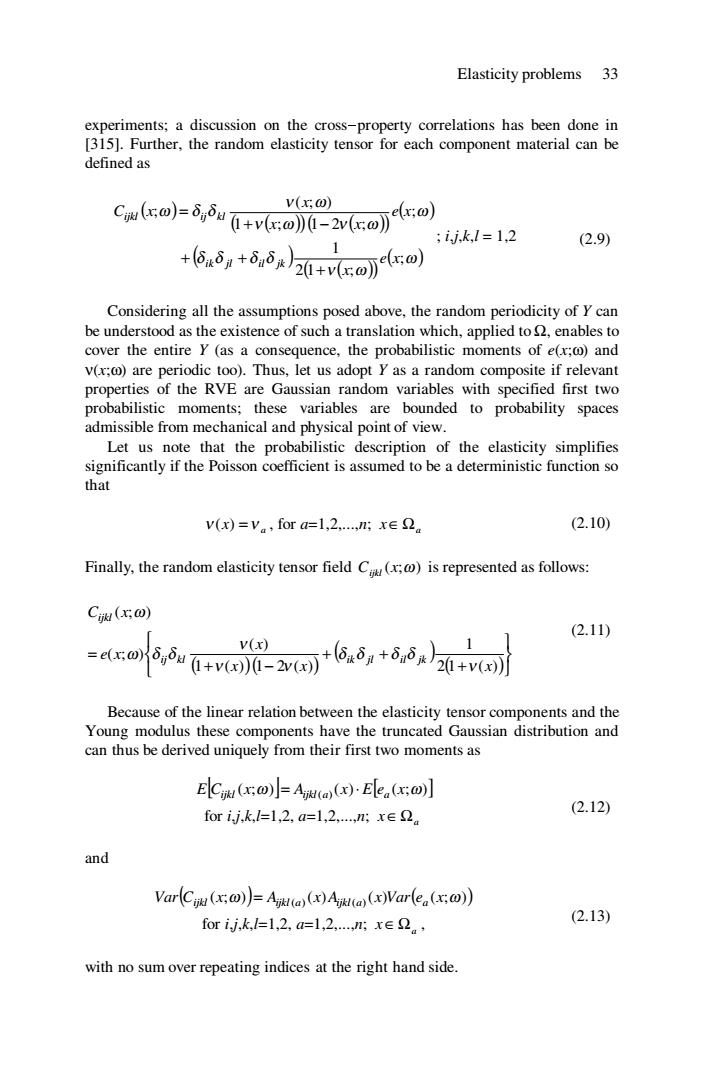正在加载图片...

Elasticity problems 33 experiments;a discussion on the cross-property correlations has been done in [315].Further,the random elasticity tensor for each component material can be defined as v(x;@) Cw)8uvv) ij,k,l=1,2 (2.9) +6.d,+dirxlh0ieortcoj Considering all the assumptions posed above,the random periodicity of Y can be understood as the existence of such a translation which,applied to enables to cover the entire Y(as a consequence,the probabilistic moments of e(x;0)and v(x;0)are periodic too).Thus,let us adopt Y as a random composite if relevant properties of the RVE are Gaussian random variables with specified first two probabilistic moments;these variables are bounded to probability spaces admissible from mechanical and physical point of view. Let us note that the probabilistic description of the elasticity simplifies significantly if the Poisson coefficient is assumed to be a deterministic function so that v(x)=v,for a=1,2,....n;xe (2.10) Finally,the random elasticity tensor field C(x is represented as follows: Cw(xω) (2.11) =co6a+a西*低5,+.l30同 v(x) Because of the linear relation between the elasticity tensor components and the Young modulus these components have the truncated Gaussian distribution and can thus be derived uniquely from their first two moments as ElCi (x:)]=Aik(a(x)-Elea(x:)] for ij.k,l=1,2,a=1,2,...n;xE (2.12) and Var(C(x:))=Ajkt(a)(x)Ajl(a (x)Var(ea(x:)) for ij,k,1=1,2,a=1,2,xe2。, (2.13) with no sum over repeating indices at the right hand side.Elasticity problems 33 experiments; a discussion on the cross-property correlations has been done in [315]. Further, the random elasticity tensor for each component material can be defined as ( ) ( ) () ( ) ( ) ( ) ( ) ( ) ( ) ( ) ω ν ω δ δ δ δ ω ν ω ν ω ν ω ω δ δ ; 2 1 ; 1 ; 1 ; 1 2 ; ( ; ) ; e x x e x x x x C x ik jl il jk ijkl ij kl + + + + − = ; i,j,k,l = 1,2 (2.9) Considering all the assumptions posed above, the random periodicity of Y can be understood as the existence of such a translation which, applied to Ω, enables to cover the entire Y (as a consequence, the probabilistic moments of e(x;ω) and ν(x;ω) are periodic too). Thus, let us adopt Y as a random composite if relevant properties of the RVE are Gaussian random variables with specified first two probabilistic moments; these variables are bounded to probability spaces admissible from mechanical and physical point of view. Let us note that the probabilistic description of the elasticity simplifies significantly if the Poisson coefficient is assumed to be a deterministic function so that a ν ( , for x) =ν a=1,2,...,n; a x∈Ω (2.10) Finally, the random elasticity tensor field ) Cijkl (x;ω is represented as follows: ( )( ) ( ) ( ) ⎩ ⎨ ⎧ ⎭ ⎬ ⎫ + + + + − = 2 1 ( ) 1 1 ( ) 1 2 ( ) ( ) ( ; ) ( ; ) x x x x e x C x ij kl ik jl il jk ijkl ν δ δ δ δ ν ν ν ω δ δ ω (2.11) Because of the linear relation between the elasticity tensor components and the Young modulus these components have the truncated Gaussian distribution and can thus be derived uniquely from their first two moments as [ ( ; )] ( ) [ ] ( ; ) E Cijkl x ω = Aijkl(a) x ⋅ E ea x ω for i,j,k,l=1,2, a=1,2,...,n; a x∈Ω (2.12) and ( ( ; )) ( ) ( ) ( ) ( ; ) Var Cijkl x ω = Aijkl(a) x Aijkl(a) x Var ea x ω for i,j,k,l=1,2, a=1,2,...,n; a x∈Ω , with no sum over repeating indices at the right hand side. (2.13)